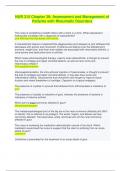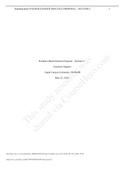NUR 315 Chapter 38: Assessment and Management of
Patients with Rheumatic Disorders
The nurse is completing a health history with a client in a clinic. What assessment
finding best correlates with a diagnosis of osteoarthritis?
joint stiffness that decreases with activity
A characteristic feature of osteoarthritis (degenerative joint disease) is joint stiffness that
decreases with activity and movement. Erythema and edema over the affected joint,
anorexia, weight loss, and fever and malaise are associated with rheumatoid arthritis, a
more severe and destructive form of arthritis.
Which newer pharmacological therapy, used to treat osteoarthritis, is thought to prevent
the loss of cartilage and repair chondral defects, as well as have some anti-
inflammatory effects?
Viscosupplementation
Viscosupplementation, the intra-articular injection of hyaluronates, is thought to prevent
the loss of cartilage and repair chondral defects. It may also have some anti-
inflammatory effects. Glucosamine and chondroitin are thought to improve tissue
function and retard breakdown of cartilage. Capsaicin is a topical analgesic.
The presence of crystals in synovial fluid obtained from arthrocentesis is indicative of
gout
The presence of crystals is indicative of gout, whereas the presence of bacteria is
indicative of infective arthritis.
Which joint is most commonly affected in gout?
Metatarsophalangeal
The metatarsophalangeal joint of the big toe is the most commonly affected joint (90%
of clients); this is referred to as podagra. The wrists, fingers, and elbows are less
commonly affected. The tarsal area, ankle, and knee are not the most commonly
affected in gout.
The nurse is reviewing the medication administration record of the client. Which
medication would lead the nurse to suspect that the client is suffering from an acute
attack of gout?
colchicine
Colchicine is prescribed for the treatment of an acute attack of gout.
,A client with gout has been advised to lose weight. The client informs the nurse of plans
to go on a "guaranteed rapid weight loss" plan that involves fasting and heavy exercise.
Which response would be most appropriate?
"There might be some difficulties with your plan and fasting."
Clients should avoid fasting, low-carbohydrate diets, and rapid weight loss because
these measures increase the likelihood of ketone formation, which inhibits uric acid
excretion. Gradual weight loss helps reduce serum uric acid levels in clients with gout.
Which of the following disorders is characterized by an increased autoantibody
production?
Systemic lupus erythematosus (SLE)
SLE is an immunoregulatory disturbance that results in increased autoantibody
production. Scleroderma occurs initially in the skin but also occurs in blood vessels,
major organs, and body systems, potentially resulting in death. Rheumatoid arthritis
results from an autoimmune response in the synovial tissue, with damage taking place
in body joints. In polymyalgia rheumatic, immunoglobulin is deposited in the walls of
inflamed temporal arteries.
The nurse intervenes to assist the client with fibromyalgia to cope with which
symptoms?
Chronic fatigue, generalized muscle aching, and stiffness
Fibromyalgia is a common condition that involves chronic fatigue, generalized muscle
aching, and stiffness. The cause is unknown, and no pathologic characteristics specific
for the condition have been identified. Treatment consists of attention to the specific
symptoms reported by the client. NSAIDs may be used to treat the diffuse muscle
aching and stiffness. Tricyclic antidepressants are used to improve or restore normal
sleep patterns, and individualized programs of exercise are used to decrease muscle
weakness and discomfort and to improve the general deconditioning that occurs in
these individuals.
A client with rheumatoid arthritis reports joint pain. What intervention is a priority to
assist the client?
Nonsteroidal anti-inflammatory drugs
Nonsteroidal anti-inflammatory drugs are the mainstay of treatment for rheumatoid
arthritis pain. They help to decrease inflammation in the joints. Heat, rather than ice
packs, is used to relieve pain. Paraffin baths may also help. Surgery is reserved for joint
replacement when the joint is no longer functional; it is not an intervention specific to
relieving pain.
The nurse is caring for a client with a new onset of gout. What medication does the
nurse anticipate will be ordered by the health care provider?
, colchicine
The treatment of gout involves managing the acute inflammatory stage, preventing
flare-ups, and controlling hyperuricemia. Colchicine, along with indomethacin, ibuprofen,
or a corticosteroid, is prescribed to relieve an acute attack of gout. Probenecid and
anturane increase the urinary excretion of uric acid, and allopurinol breaks down
purines before uric acid is formed.
A client asks the nurse what the difference is between osteoarthritis (OA) and
rheumatoid arthritis (RA). Which response is correct?
"OA is a noninflammatory joint disease. RA is characterized by inflamed, swollen joints."
OA is a degenerative arthritis, characterized by the loss of cartilage on the articular
surfaces of weight-bearing joints with spur development. RA is characterized by
inflammation of synovial membranes and surrounding structures. OA may occur in one
hip or knee and not the other, whereas RA commonly affects the same joints bilaterally.
RA is more common in women; OA affects both sexes equally.
The client asks the nurse about types of exercise that do not stress the joints. What
exercise will the nurse include in the teaching plan?
t'ai chi
T'ai chi is low impact, so this is the best exercise for low joint impact. Jogging, weight
lifting, and running on a treadmill are high-impact, jarring types of exercise.
The client with osteoarthritis is seen in the clinic. Which assessment finding indicates
the client is having difficulty implementing self-care?
Has a weight gain of 5 pounds
Obesity is a risk factor for osteoarthritis. Excess weight is a stressor on the weight-
bearing joints. Weight reduction is often a part of the therapeutic regimen.
The nurse is assessing a client with a history of ankylosing spondylitis. What will the
nurse most commonly assess?
low back pain
The most common symptoms of ankylosing spondylitis are low back pain and stiffness.
A red, butterfly-shaped rash on the face and a patchy loss of hair are associated with
systemic lupus erythematosus. Ankylosing spondylitis does not affect urine output.
The nurse is reviewing the diagnostic test findings of a client with rheumatoid arthritis.
What would the nurse expect to find?
Elevated erythrocyte sedimentation rate
The erythrocyte sedimentation rate (ESR) may be elevated, particularly as the disease
progresses. ESR shows inflammation associated with RA. Red blood cell count and C4





